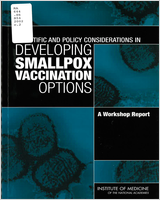NCBI Bookshelf. A service of the National Library of Medicine, National Institutes of Health.
Institute of Medicine (US) Board on Health Promotion and Disease Prevention. Scientific and Policy Considerations in Developing Smallpox Vaccination Options: A Workshop Report. Washington (DC): National Academies Press (US); 2002.

Scientific and Policy Considerations in Developing Smallpox Vaccination Options: A Workshop Report.
Show detailsThe threat of smallpox has not changed appreciably since ACIP last reviewed smallpox immunization policy in June 2001. It remains difficult to obtain the virus, prepare it, and distribute it. What has changed is the availability of vaccine.
Dryvax, the vaccinia (smallpox) vaccine currently licensed in the United States, is a lyophilized, live-virus preparation of infectious vaccinia virus, produced in 1975 by Wyeth Laboratories, Inc., of Marietta, Pennsylvania. Vacciniad vaccine does not contain smallpox (variola) virus. Previously, the vaccine had been prepared from calf lymph with a seed virus derived from the New York City Board of Health strain of vaccinia virus. Vaccine was administered by using the multiple-puncture technique with a bifurcated needle. A reformulated vaccine, produced by using cell-culture techniques, is now being developed.
In fall 2001, there were 150,000 ampules of Dryvax, available at 100 doses per ampule, which would vaccinate 15 million people. However, because Dryvax is a dried product, once reconstituted it begins to deteriorate at a rapid rate, so there is a finite period of time in which it can be used, which can create substantial wastage. In September 2001, DHHS placed an order for 40 million doses of vaccine with Acambis, Inc. The 20-year contract would purchase a new vaccine produced in tissue cell culture, to be available in 2004. However, the September 11, 2001, attacks and the release of the anthrax organisms through the mail spurred the government to acquire more vaccine more quickly. Acambis and Baxter are currently producing 200 million doses of a stable tissue cell culture vaccine to be available by the end of 2002. Also in 2002, Aventis Pasteur located in a storage facility 85 million doses of vaccine prepared from calf lymph, produced in 1958. This vaccine has been tested and is available if needed; however, the newer vaccine produced in tissue cell culture is preferable.
Now that sufficient vaccine will be available for the entire U.S. population should it be needed, a responsible immunization strategy must be developed. Previous experience with immunization has shown that serious complications can arise in as much as 20 percent of those who come in contact with vaccinees but are not yet vaccinated and are susceptible to complications for a variety of reasons.
Footnotes
- 2
The opening remarks for the meeting were presented by D.A.Henderson from Johns Hopkins University.
- OPENING REMARKS - Scientific and Policy Considerations in Developing Smallpox Va...OPENING REMARKS - Scientific and Policy Considerations in Developing Smallpox Vaccination Options
- ETHICAL, LEGAL, AND SOCIAL ISSUES - Scientific and Policy Considerations in Deve...ETHICAL, LEGAL, AND SOCIAL ISSUES - Scientific and Policy Considerations in Developing Smallpox Vaccination Options
Your browsing activity is empty.
Activity recording is turned off.
See more...